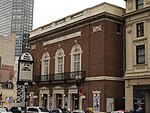Downtown Boston

Downtown Boston is the central business district of Boston, Massachusetts, United States. The city of Boston was founded in 1630. The largest of the city's commercial districts, Downtown is the location of many corporate or regional headquarters; city, county, state and federal government facilities; and many of Boston's tourist attractions. Similar to other central business districts in the U.S., Downtown has recently undergone a transformation that included the construction of new condos and lofts, renovation of historic buildings, and arrival of new residents and businesses. It is represented in the Boston City Council by District 2's Bill Linehan. Downtown is bound by the Back Bay, North End, Beacon Hill, and the South End areas. It includes Government Center and the Financial District.The area that is now Downtown Boston constituted much of the town/city proper prior to the city's dramatic expansion in the 1860s and 1870s. The Great Boston Fire of 1872 destroyed much of the neighborhood, especially between Summer, Washington, and Milk Streets. In the 1950s the Central Artery highway began operating, until the Big Dig (1982-2007) relocated it underground. In the 1960s and 1970s the enormous new Government Center complex replaced Scollay Square. Landmarks in Downtown Boston include the Greenway, Custom House Tower, City Hall, Faneuil Hall, Quincy Market, Old State House, Old South Meeting House, Massachusetts State House, Park Street Church, Boston Common, and Boston Public Garden.Educational institutions located downtown include Emerson College and Suffolk University. The four MBTA subway lines converge in the downtown area at the Downtown Crossing, Park Street, Government Center, and State stations. South Station is a transportation hub with subway, commuter rail, intercity bus, and Amtrak service.
Excerpt from the Wikipedia article Downtown Boston (License: CC BY-SA 3.0, Authors, Images).Downtown Boston
Charles Street South, Boston
Geographical coordinates (GPS) Address Nearby Places Show on map
Geographical coordinates (GPS)
| Latitude | Longitude |
|---|---|
| N 42.35 ° | E -71.066666666667 ° |
Address
Charles Street South 78
02111 Boston
Massachusetts, United States
Open on Google Maps





